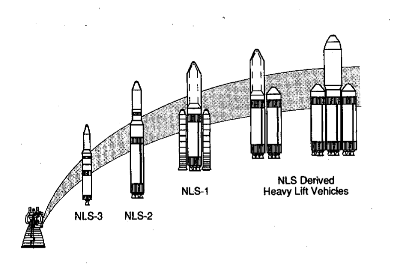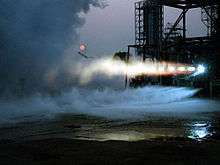National Launch System

The National Launch System (or New Launch System) was a study authorized in 1991 by President George H. W. Bush to outline alternatives to the Space Shuttle for access to Earth Orbit.[1] Shortly thereafter, NASA asked Lockheed Missiles and Space, McDonnell Douglas, and TRW, to perform a ten-month study.[2] A series of launch vehicles was proposed, based around the Space Transportation Main Engine (STME) liquid-fuel rocket engine, a proposed simplified, expendable version of the Space Shuttle Main Engine (SSME).[3][4] The largest of three proposed vehicles was designated NLS-1 and used for its core stage a modified Space Shuttle External Tank which would feed liquid Oxygen and liquid Hydrogen to four STMEs attached to the bottom of the tank. A payload or second stage would fit atop the core stage, and two detachable Shuttle Solid Rocket Boosters would be mounted on the sides of the core stage as on the Shuttle.[3] Period illustrations suggest that much larger rockets than NLS-1 were contemplated, using multiples of the NLS-1 core stage.[5][6]
Program cancellation

The NLS program did not venture beyond the planning stages and did not survive the ascendancy of the Clinton administration in 1993. Perhaps the inevitable was already clear by 1992 with the selection of Daniel S. Goldin to replace Vice Admiral Richard H. Truly as NASA administrator. Goldin championed the motto, "faster, better, cheaper,"[7] which may not have appeared to fit the ambitious NLS vision. A NASA history from 1998 offers that reusable Single-stage-to-orbit (SSTO) rockets and space planes such as the DC-X and X-33 seemed attainable and represented smaller, simpler alternatives to the sprawling Shuttle program.[8] NLS, by contrast, was more of a continuation of the Shuttle legacy. Whether it was ever explicitly stated, by the beginning of the Clinton administration, the expensive Space Shuttle and planned Space Station Freedom programs had enough momentum to continue, and the SSTO projects showed enough promise to fund. There was no budget left for another big program, the National Launch System.
Legacy
Soon after the faster, better, cheaper Evolved Expendable Launch Vehicle (EELV) was proposed by the United States Air Force in 1994, Rocketdyne realized that they would need a powerful, simple engine for the proposed liquid-fueled Common Booster Core (CBC). NLS research on the STME, a simpler SSME, served as a starting point for the greatly simplified RS-68 that powers the current Delta IV EELV rocket.[9] The Delta IV Heavy rocket, composed of three Common Booster Cores, has already launched, and plans exist for rockets with as many as seven CBCs.[10] It could be argued that with its SSME-derived engines and bundled Common Booster Core form, the Delta IV Heavy rocket represents an embodiment of the National Launch System ideal, albeit on a smaller scale.
See also
- Human Explorations Framework Team (2010–2011)
- Space Launch System (2010 - )
- Review of United States Human Space Flight Plans Committee (Augustine Committee, 2009)
- DIRECT (2006 - )
- Exploration Systems Architecture Study (2005)
- Vision for Space Exploration (2004 - )
- Space Launch Initiative (ca. 2002 - 2004)
- National Space Policy (1996)
- Space Launch Modernization Plan (1994)
- Spacelifter program (1993)
- Access to Space Study (1993)
- Advanced Transportation System Studies (1992–1994)
- National Launch System (1991–1993)
- National AeroSpace Plane (ca. 1990 - 1993)
- Advisory Committee on the Future of the U.S. Space Program (Augustine Committee, 1990)
- Space Exploration Initiative (1989)
- Advanced Launch System (1987–1990)
- List of space launch system designs
Notes
- ↑ Bush 1991.
- ↑ Flight International 1991, p. 12.
- 1 2 Lyons 1992, p. 19.
- ↑ Federation of American Scientists 1996.
- ↑ Lyons 1992, Figure 1.
- ↑ Duffy, Lehner & Pannell 1993, Figure 1.
- ↑ Thompson & Davis 2009.
- ↑ NASA History Division 1998.
- ↑ Wood 2002, p. 1.
- ↑ Boeing 2005, p. 50.
References
- Boeing (c. 2005), Delta Launch 310 – Delta IV Heavy Demo Media Kit (PDF) http://www.boeing.com/defense-space/space/delta/kits/d310_d4heavy_demo.pdf, retrieved 2010-04-25 Missing or empty
|title=(help);|contribution=ignored (help)
- Bush, George H. W. (1991), National Space Launch Strategy NSPD-4, July 10, 1991, retrieved 2010-04-25
- Duffy, J. B.; Lehner, J. W.; Pannell, B. (1993). "Evaluation of the national launch system as a booster for the HL-20". Journal of Spacecraft and Rockets. 30 (5): 622. Bibcode:1993JSpRo..30..622D. doi:10.2514/3.25574.
- Federation of American Scientists (1996), National Launch System - NLS, retrieved 2010-04-25
- Flight International (28 August – 3 September 1991), "NASA Sets up 10-month NLS study", Flight International, 4 (4282), retrieved 2010-04-25.
- Lyons, Michael T. (1992), "National launch system and its potential application to the launch of geosynchronous satellites." (PDF), AIAA International Communication Satellite Systems Conference and Exhibit, 14th, Washington, DC, Mar 22-26, 1992, Technical Papers. Pt. 1 (A92-29751 11-32)., American Institute of Aeronautics and Astronautics, pp. 18–22, retrieved 2010-04-25
- NASA History Division (23 September 1998), "The Policy Origins of the X-33 Part II: The NASA Access to Space Study", X-33 History Project, National Aeronautics and Space Administration, retrieved 2010-04-25
- Thompson, Elvia; Davis, Jennifer (4 November 2009), Daniel Saul Goldin NASA Administrator, April 1, 1992 - November 17, 2001, National Aeronautics and Space Administration, retrieved 2010-04-25
- Wood, B. K. (2002), "Propulsion for the 21st Century—RS-68", 38th Joint Liquid Propulsion Conference, Indianapolis, Indiana. July 2002. Reston, Virginia, USA., American Institute of Aeronautics and Astronautics, retrieved 2010-04-25
External links
- EELV - Boeing Contains good summary of NLS from an early 1990s perspective.
- Cycle 0(CY1991) NLS trade studies and analyses report. Book 1: Structures and core vehicle
- Cycle O (CY 1991) NLS trade studies and analyses, book 2. Part 1: Avionics and systems
- Cycle O(CY1991) NLS trade studies and analyses report. Book 2, part 2: Propulsion
- Many documents on NLS are available at the NASA Technical Reports Server, administered by the NASA Scientific and Technical Information Program Office. Search term: NLS